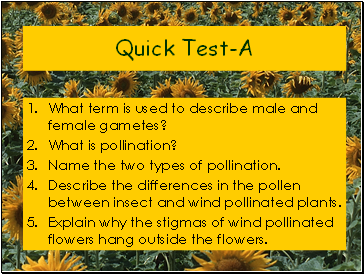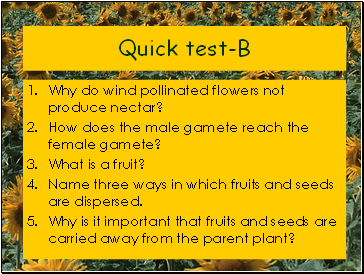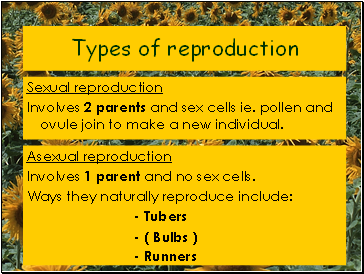Growing PlantsPage
4
4
Slide 36
Activity
Listening exercise on seed dispersal
Listen to the tape,
Use the commentary to help you answer questions on your handout.
World of Plants Workbook p41
Comparing Lime and Sycamore seeds.
Go through the problem solving activity
Slide 37
Quick Test-A
What term is used to describe male and female gametes?
What is pollination?
Name the two types of pollination.
Describe the differences in the pollen between insect and wind pollinated plants.
Explain why the stigmas of wind pollinated flowers hang outside the flowers.
Slide 38
Quick test-B
Why do wind pollinated flowers not produce nectar?
How does the male gamete reach the female gamete?
What is a fruit?
Name three ways in which fruits and seeds are dispersed.
Why is it important that fruits and seeds are carried away from the parent plant?
Slide 39
Types of reproduction
Sexual reproduction
Involves 2 parents and sex cells ie. pollen and ovule join to make a new individual.
Asexual reproduction
Involves 1 parent and no sex cells.
Ways they naturally reproduce include:
- Tubers
- ( Bulbs )
- Runners
Slide 40
Tubers
Tubers are underground food stores which stores food over the winter and provides a new plant with food until it can make its own.
Food made by the new plant is sent to make new tubers. Thereby reproducing itself.
Examples: potato, artichoke, yam, cassava, water chestnut, arrowroot
Slide 41
arrowroot = arrow root = Chinese potato (this name also is used for jicama) = goo = seegoo = arrowhead = Chinese arrowhead = tse goo = ci gu = tsu goo
Arrowroot
Notes: The name arrowroot is more commonly associated with a thickener that's made from the plant.
A fresh arrowroot tuber looks like a small onion, only without the layers.
It should be peeled, and then it can be boiled or stir-fried.
Look for it in Chinese markets during the winter.
Slide 42
Cassava
cassava = casava = manioc = mandioca = tapioca root = yucca = yucca root = yuca root = Brazilian arrowroot Pronunciation: kuh-SAH-vuh
Notes: People in Hispanic countries use cassavas much like Americans use potatoes. There's both a sweet and a bitter variety of cassava. The sweet one can be eaten raw, but the bitter one requires cooking to destroy the harmful prussic acid it contains.
Contents
- The life cycle of a plant
- Seed Structure
- Seed Dissection
- Seeds
- Investigation: Germination
- What affects germination?
- Germination and Temperature
- Germination conditions
- Germination and Temperature
- Structure of a Flower
- Pollination
- Insect Pollinated Plants
- Wind Pollinated Plants
- Pollination Activity
- Pollination Summary
- Fertilisation
- Pollen tubes
- Pollen tube growth
- Fertilisation
- Seed Dispersal
- Tubers
- Cassava
- Topinambour
- Bulbs
- Flame violet
- Clones
- Artificial Propagation
- Commercial aspects
Last added presentations
- Heat-Energy on the Move
- Static and Kinetic Friction
- Buoyancy
- Resource Acquisition and Transport in Vascular Plants
- Upcoming Classes
- Radiation
- Radioactivity and Nuclear Reactions







